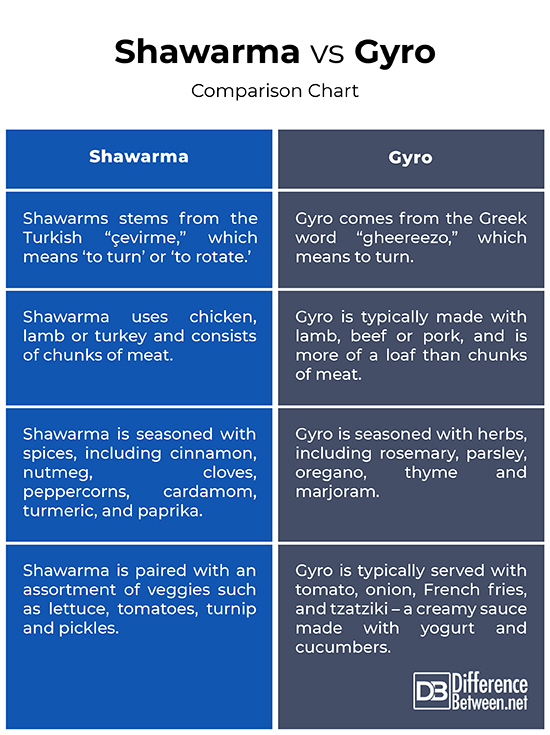Difference Between Shawarma and Gyro
Shawarma and gyro has to be one of the most unappetizing-looking meaty delights that you could eat. Watching the meat rotate on a vertical split, you can’t help but be reminded of the popular meat dishes of the Middle East, from which tacos probably derive. Both are sliced seasoned meat wrapped in a kind of bread or a pita and served with salad and sauce. Both look very much alike from the outside, but there are some subtle differences between the two.

What is Shawarma?
Shawarma is a popular meat dish cooked at a very high temperature on a vertical rotisserie, and cut into thin slices of meat. It is a dish of debated origins and may owe its origins to the Turks, who call it a ‘doner kebab,’ or the Arabs, who call it “Shawarma.” The meat is usually chicken, lamb or turkey and consists of chunks of meat rolled into a flatbread or pita that has been steamed or heated. It was believed to have originated from the Middle East, where it is made of highly seasoned minced meat wrapped around a rotating spit and slowly roasted. The meat tastes so juicy and flavorful, as it is marinated in spices like cinnamon, nutmeg, cloves, peppercorns, turmeric, and garlic. The word “Shawarma“actually comes from the Turkish “çevirme,” which means ‘to turn’ or ‘to rotate,’ which describes the slow cooking process in front of a fire.

What is Gyro?
Gyro (pronounced YEE-row) is a classic, authentic Greek dish derived from the Turkish ‘doner kebab’ and made with sliced, marinated meat that is cooked on a vertical spit, just like shawarma. It is made with stacked meat; lamb, beef and pork. Gyros may also refer to the sandwich with the same ingredients. Greek gyro was made traditionally from pork, while the Americans typically use lamb and ground beef, or a scrumptious assortment of the two. Chicken is also common and the thinly sliced pieces of meat are stacked on a spit. It is beautifully seasoned with a blend of rosemary, parsley, oregano, thyme and marjoram along with some garlic and onion powder. Gyro is typically served wrapped or served in a pita with tomato, onion, French fries, and tzatziki (a Greek sauce made with cucumbers and yogurt).
Difference between Shawarma and Gyro
Origin
– Both also look remarkably alike from the outside, but despite the many similarities, they are quite different. Shawarma is a Middle Eastern meaty delight whoso origins can be traced back to the 18th or 19th century Ottoman Empire, while its name stems from the Turkish “çevirme,” which means ‘to turn’ or ‘to rotate.’ Gyro is a popular Greek dish believed to have originated in Greece in 1922. Gyro comes from the Greek word “gheereezo,” which means to turn.
Meat
– Both shawarma and gyro are popular meat dishes cooked at a very high temperature on a rotating skewer and slowly roasted, allowing for the meat to be cooked in its own fat. Both are served on a flatbread or pita that has been steamed or heated. The main difference is the meat. Shawarma uses chicken, lamb or turkey and consists of chunks of meat. Gyro, on the other hand, is typically made with lamb, beef or pork, and is more of a loaf than chunks of meat.
Seasoning
– Another major difference between the two dishes is the way the meat is prepared and seasoned. Shawarma is marinated in spices like cinnamon, nutmeg, cloves, peppercorns, cardamom, turmeric, and garlic. Gyro, on the other hand, is seasoned with a blend of rosemary, parsley, oregano, thyme and marjoram along with some garlic and onion powder, and served with tomato, onion, French fries, and tzatziki (a Greek sauce made with cucumbers and yogurt).
Shawarma vs. Gyro: Comparison Chart

Summary
Both shawarma and gyro are descendants of the already popular doner kebab, a Turkish kebab made of meat and cooked on a vertical rotisserie. One of the main differences between the two is the choice of meat; shawarma typically uses chicken, lamb or turkey, while gyro is made with lamb, beef or pork. Shawarma is seasoned with spices, while gyro is seasoned with Mediterranean herbs. Shawarma is typically paired with assortment of vegetables, such as tomato, lettuce, turnip and pickles. Gyro is served with tomato, onion and a creamy sauce made with cucumber and yogurt called tzatziki.
What exactly is shawarma?
Shawarma is a popular Middle Eastern meat dish that is cooked at a very high temperature on a vertical rotisserie, and cut into thin slices of meat. The meat is usually chicken, lamb or turkey and consists of chunks of meat rolled into a flatbread or pita.
What came first shawarma or gyro?
Gyros became popular in the United States in the 1970’s. Shawarma was believed to have originated in the 18th or 19th century Ottoman Empire. Shawarma is from Turkey whereas gyro came from Greece.
What is the meat in a gyro called?
Gyro was traditionally made from pork, but the Americans use lamb, beef or an assortment of the two. Chicken is also common today. Unlike shawarma, it consists of a loaf of sliced meats.
- Difference Between Caucus and Primary - June 18, 2024
- Difference Between PPO and POS - May 30, 2024
- Difference Between RFID and NFC - May 28, 2024
Search DifferenceBetween.net :
Leave a Response
References :
[0]Hartwig, Melissa. The Whole30 Slow Cooker: 150 Totally Compliant Prep-and-Go Recipes for Your Whole30. Massachusetts, United States: Houghton Mifflin Harcourt, 2018. Print
[1]Bonanos, Christopher. Gods, Heroes, And Philosophers: A Celebration Of All Things Greek. New York, United States: Kensington Publishing Corp., 2013. Print
[2]Helou, Anissa. Feast: Food of the Islamic World. London, United Kingdom: Bloomsbury Publishing, 2018. Print
[3]Image credit: https://commons.wikimedia.org/wiki/File:Gyro_on_pita_bread_with_toppings.jpg
[4]Image credit: https://live.staticflickr.com/8460/8032467829_fba9597d49_b.jpg
